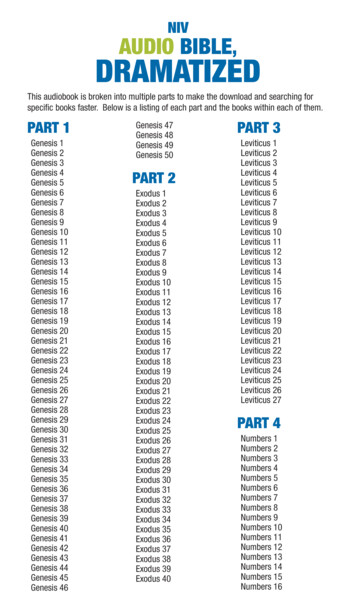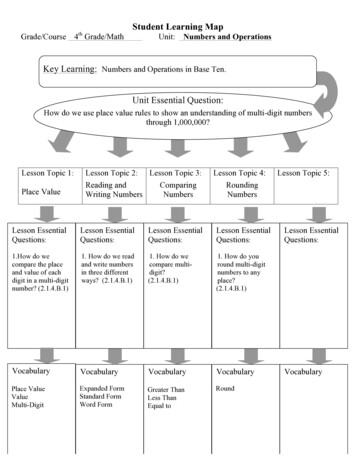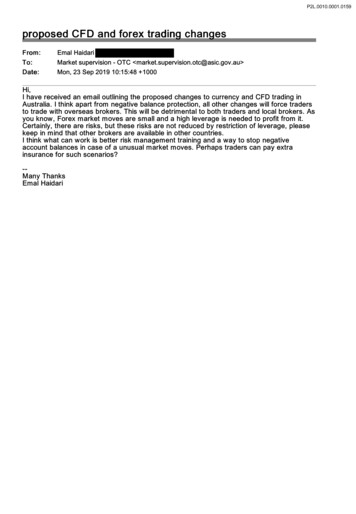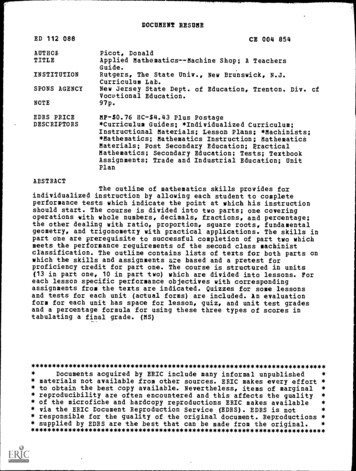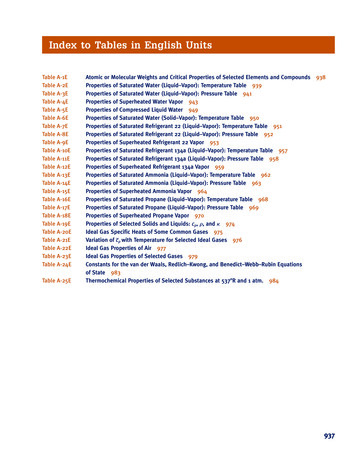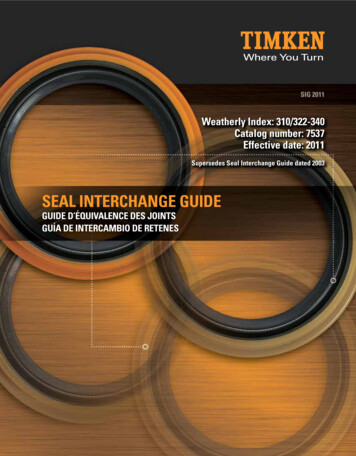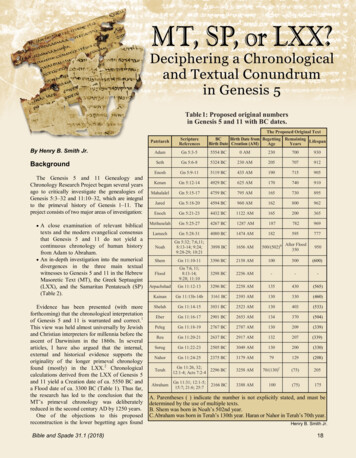
Transcription
Table 1: Proposed original numbersin Genesis 5 and 11 with BC dates.The Proposed Original TextPatriarchScriptureReferencesAdamGn 5:3-55554 BC0 AM230700930SethGn 5:6-85324 BC230 AM205707912EnoshGn 5:9-115119 BC435 AM190715905KenanGn 5:12-144929 BC625 AM170740910MahalalelGn 5:15-174759 BC795 AM165730895JaredGn 5:18-204594 BC960 AM162800962EnochGn 5:21-234432 BC1122 AM165200365 A close examination of relevant biblicalMethuselahGn 5:25-274267 BC1287 AM187782969texts and the modern evangelical consensusthat Genesis 5 and 11 do not yield acontinuous chronology of human historyfrom Adam to Abraham. An in-depth investigation into the numericaldivergences in the three main textualwitnesses to Genesis 5 and 11 in the HebrewMasoretic Text (MT), the Greek Septuagint(LXX), and the Samaritan Pentateuch (SP)(Table 2).LamechGn 5:28-314080 BC1474 AM182595777NoahGn 5:32; 7:6,11;8:13-14; 9:24;9:28-29; 10:213898 BC1656 AM500/(502)BAfter Flood350950ShemGn 11:10-113396 BC2158 AM100500(600)FloodGn 7:6, 11;8:13-14;9:28; 11:103298 BC2256 AM---ArpachshadGn 11:12-133296 BC2258 AM135430(565)KainanGn 11:13b-14b3161 BC2393 AM130330(460)ShelahGn 11:14-153031 BC2523 AM130403(533)EberGn 11:16-172901 BC2653 AM134370(504)PelegGn 11:18-192767 BC2787 AM130209(339)ReuGn 11:20-212637 BC2917 AM132207(339)SerugGn 11:22-232505 BC3049 AM130200(330)NahorGn 11:24-252375 BC3179 AM79129(208)Gn 11:26, 32;2296 BC12:1-4; Acts 7:2-43258 AM70/(130)C(75)205Gn 11:31; 12:1-5;15:7; 21:6; 25:73388 AM100(75)175By Henry B. Smith Jr.BackgroundThe Genesis 5 and 11 Genealogy andChronology Research Project began several yearsago to critically investigate the genealogies ofGenesis 5:3–32 and 11:10–32, which are integralto the primeval history of Genesis 1–11. Theproject consists of two major areas of investigation:Evidence has been presented (with moreforthcoming) that the chronological interpretationof Genesis 5 and 11 is warranted and correct.1This view was held almost universally by Jewishand Christian interpreters for millennia before theascent of Darwinism in the 1860s. In severalarticles, I have also argued that the internal,external and historical evidence supports theoriginality of the longer primeval chronologyfound (mostly) in the LXX.2 Chronologicalcalculations derived from the LXX of Genesis 5and 11 yield a Creation date of ca. 5550 BC anda Flood date of ca. 3300 BC (Table 1). Thus far,the research has led to the conclusion that theMT’s primeval chronology was deliberatelyreduced in the second century AD by 1250 years.One of the objections to this proposedreconstruction is the lower begetting ages foundBible and Spade 31.1 (2018)TerahAbrahamBegetting RemainingLifespanAgeYears2166 BCA. Parentheses ( ) indicate the number is not explicitly stated, and must bedetermined by the use of multiple texts.B. Shem was born in Noah’s 502nd year.C. Abraham was born in Terah’s 130th year. Haran or Nahor in Terah’s 70th year.Henry B. Smith Jr.18
Table 2: The main numerical divergences in Genesis 5 and 11 in the Masoretic Text (MT), Septuagint(LXX), and Samaritan Pentateuch (SP). Endnotes provide sources and explanations for some figures.Masoretic 0730800200782565B950500/(502)After theFlood350800807815840800782595BSamaritan PentateuchRemainingBegetting 895962365969753B13010590706562A6567 A53 A800807815840830785 A300653 A600 A930912905910895847 A365720 A653A950500/(502)After theFlood350950500/(502)After 32302911:26, 32;12:1-4Acts 7:2-4205205A. Smith Jr., “Methuselah’s Begetting Age,” 170, n. 5.B. Brief explanations for Lamech’s numbers can be found in Ibid., 170, n. 6-7.C. Ibid., 170, n. 8.D. Ibid., 171, n. 13.E. Arpachshad’s remaining years in the MT are 403. I propose the figure was originally 430. Ibid., 171, n. 9.F. For commentary on Kainan, see: Smith Jr., “From Adam to Abraham: An Update on the Genesis 5 and 11 ResearchProject,” 2017; “The Case for the Septuagint’s Chronology in Genesis 5 and 11,” 2018, Appendix n. 11.G. Smith Jr., “Methuselah’s Begetting Age,” 171, n. 10. Some LXX MSS read 330.H. Eber’s original remaining years are 370. The MT reads 430. Cosner and Carter, 103–104; Hendel, 73.I. I slightly favor 129 as original. The MT reads 119. Smith Jr., “Methuselah’s Begetting Age,” 171, n. 12.J. Brackets [ ] indicate reconstructions of MT readings.Henry B. Smith Jr.in Genesis 5 of the SP. From Adam to Mahalalel, and thenEnoch, these figures match those found in the Masoretic Text(Table 2). Some scholars have argued their matchingcharacter favors them as the original text. 3 Since I haveproposed that the lower begetting ages in the MT are theresult of deliberate and systematic deflation, an explanationfor the independent appearance of these particular figures inthe SP must be offered. The purpose of this article is topresent a plausible theory explaining why the SP was alsodeflated in Genesis 5.Overview of the Samaritan PentateuchInterest in the SP has increased dramatically in the last fewdecades, evidenced by the studies of Kartveit, Pummer,Anderson and Giles, and numerous others.4 Written in anarchaic Hebrew script, the SP is a text of the Torah that19developed amongst the Samaritans in partial isolation frommainstream Judaism.5 The SP contains the five books ofMoses, and is an important witness to the textual history of thePentateuch. A substantial portion of the SP affirms theantiquity and accurate preservation of much of the MasoreticHebrew Text, the base text for our modern OT translations. 6The SP contains updated spelling and tends to harmonizeparallel accounts. A thin layer of sectarian readings is alsofound in the SP, such as placing Abraham’s sacrifice of IsaacEvidence has been presented that the chronologicalinterpretation of Genesis 5 and 11 is warranted andcorrect. This view was held almost universally byJewish and Christian interpreters for millenniabefore the ascent of Darwinism in the 1860s.Bible and Spade 31.1 (2018)
on Mt. Moreh near Shechem instead of Mt. Moriah (Gn 22:2),7or locating the Temple on Mt. Gerizim instead of inJerusalem (Dt 12:5). 8 Generally speaking, scholars believethe text of the SP is closer to the Hebrew text behind theLXX (known as the Vorlage) than the MT,9 though the SPhas many affinities with the MT as well. The SP oftenconfirms and corroborates original readings found in the MTand/or LXX, but text-critical scholars rarely consider isolatedSP readings to be the originals without additionalattestation.10 For example, I reviewed Hendel’s extensivedocumentation of the text-critical divergences in the 299verses found in Genesis 1–11. Aside from the numbers inGenesis 5 and 11, Hendel ascribes original readings to the SPfor only three words out of several thousand, and thesedifferences only involve three individual Hebrew letters. 11A few examples from Genesis should help illustrate theseimportant features of the SP. Right before Cain murdersAbel (Gn 4:8), he deceives his brother by saying to him,“Let us go out into the field.” This phrase has completelydropped out of the Masoretic Text, but is preserved in boththe LXX and SP. A scribe most likely skipped over thisphrase, his eye jumping to a second instance of the word“field.” Thus, this reading in the SP is deemed reliable, butonly with corroboration from the LXX (along with theSyriac Peshitta and Latin Vulgate). 12 Similarly, in Genesis11, the begetting ages for the post-Flood patriarchs fromArpachshad to Nahor in the SP are independentlycorroborated by the LXX, and are further confirmed by adistinct external witness, Josephus. 13 Conversely, in Genesis5, all of the SP’s nine numbers for Jared, Methuselah andLamech differ from both the MT and LXX, and are certainlyinferior readings (Table 2). An SP scribe deflated the figuresfor these three patriarchs, shortening the length of theantediluvian epoch to 1307 years and causing all three mento die in the year of the Flood. We will turn our attentionback to these readings shortly.There is general agreement that important changes tookplace in the SP sometime in the second century BC. 14 PeterGentry explains:Editing in the SP also included duplication, such as theaddition of elements of Moses’ speech in Deuteronomy 1–3 tosections of both Exodus and Numbers.16 Another feature of theSP is the phenomenon of harmonizing pluses. For example, inGenesis 11:11–25, an uninspired scribe has added lifespanfigures to the text by totaling the begetting ages and remainingyears for each individual patriarch (Table 2). These areuniversally considered secondary additions (pluses) and areobviously designed to mimic (harmonize) the lifespans andepitaphs found in Genesis 5.17 Similarly, a SP scribe hasreduced Terah’s lifespan from 205 down to 145 (Gn 11:32) inan attempt to “correct” (or harmonize) the chronology ofAbraham’s life as it relates to the year of Terah’s death. Thisreading of 145 is also considered secondary. The LXX and MTboth read 205, and are original.18We have seen in these brief examples that each individualtextual scenario should be evaluated on its own merits, and theevidence must be carefully weighed when determining when/ifthe SP preserves original readings. Genesis 5 and 11 presenttheir own unique challenges, as it is certain many of thenumbers have undergone deliberate and systematic revision.While I will be proposing that many of the SP’s figures inGenesis 5 and 11 have been systematically changed, the SPplays a significant role in reconstructing the numbers, and itdoes retain some original readings.The Book of Jubilees “Rewritten Scripture”Around the same time that the SP was undergoing importantchanges, an unknown author deceptively claiming to be Mosespenned the Book of Jubilees, ca. 160–150 BC.19 Longconsidered a major work in the OT Pseudepigrapha, Jubileesalso falls under the category of “Rewritten Scripture,” definedby Eugene Ulrich as follows: the authors of these works of “Rewritten Scripture,”though having used the scriptural books as an authoritativebasis, have so changed the character of the base text and[The SP] is characterized by replacing archaiclexemes [basic units of meaning], morphology[patterns of word formation], and syntax inHebrew with those of a later linguistic tradition.Exegetical and historical difficulties have beenremoved and parallels are harmonized. Thus acomparison between the Samaritan Pentateuchand the later MT shows that many differencesbetween the two represent a modernizing of theformer in terms of grammar and spelling.15A Fragment from the Dead Sea Scrolls, 4QGenb.Discovered in Cave Four at Qumran, the right sideof this fragment contains sections of Genesis 4:2–11. On the far left of the fragment, only one word isextant: Kenan ( ) קינן from Genesis 5:13 or 14.Unfortunately, this is the only part of Genesis 5and 11 preserved in the DSS.Bible and Spade 31.1 (2018)The Leon Levy Dead Sea Scrolls Digital Library20
The oldest known scroll of the Samaritan Pentateuch, taken between 1900 and 1920.redirected the theological themes or thrust, that the newwork is no longer an exemplar of the biblical book but hasbecome a new composition (emphasis added).20As rewritten Scripture, Jubilees purports: To come from a new, divinely authorized speaker, an“angel of the presence” mediating God’s words to Moses(Jub 2:1). The invoking of both the angel and Moses areserious claims to God-ordained authority. To reveal a new theological agenda, including anadherence to a 364-day solar calendar (6:32). To serve as newly revealed revelation, originally writtenages before on “heavenly tablets” (6:17). Since theheavenly tablets are said to pre-date the Torah, Jubileespossesses a superseding authority over and above the lawof Moses. It purports to provide the proper (and ultimate)interpretation of the Torah. To provide a new chronological arrangement of sacredhistory governed by jubilee cycles (50:4). For anyone whoaccepted it as authoritative, Jubilees provided a theologicalrationale for altering chronological data in canonicalbiblical texts during the Second Temple era.There is general agreement that importantchanges took place in the SamaritanPentateuch in the second century BC.Around the same time, an unknown authordeceptively claiming to be Moses penned theBook of Jubilees, ca. 160–150 BC.21Wikimedia CommonsThis new chronological arrangement in Jubilees begins withAdam and terminates at Joshua’s entry into Canaan. As such,Jubilees imposes an artificial chronological framework onto thebiblical narrative to create a schematic history spanning 50cycles of jubilees of 49 years each.21 Biblical history isradically restructured to cause the Israelite entry into Canaan tooccur exactly on a “jubilee of jubilees,” in the year 2450 AM(Anno Mundi Year after Creation).22 The author’s intention isto subsume the history from Adam to the Conquest under thisjubilean chronological structure: “I have arranged for you theweeks of years and the jubilees—49 jubilees from the time ofAdam until today ” (Jub 50:4). Expert scholars on Jubileesagree that the externally imposed jubilee structure is absolutelycentral to the author’s purpose. Segal explains:The chronological framework of jubilees and weeks iscommon to other works of the Second Temple period thatdivide world history into eras of pre-determined length.Underlying all of them is the idea of periodization: at the endof a pre-defined length of time, the world returns to itsprimordial state .It is possible to demonstrate that thechronological framework was superimposed upon thealready existing stories (emphasis added).23The begetting ages in Jubilees for the patriarchs of Genesis 5and 11 are found in Tables 3 and 4, and how they are derived isexplained there. In order to make the jubilean structure work,the author radically altered the chronology of Genesis 5 and 11to conform it to this new revelation—a new, sacred chronologyof history governed by jubilee cycles. As a result, (almost) allof the numbers in its primeval chronology were not found inthe original biblical text, but were created by the author instead,as James Scott explains:Bible and Spade 31.1 (2018)
Jubilees shapes the biblical text, particularly Genesis toExodus, so that it conforms to the book’s own theologicalagenda and chronological scheme.”24This extensive chronological emendation and departure fromthe original text is most clearly evidenced by the begetting agesfor the patriarchs in Jubilees’ rewriting of Genesis 11. Thesefigures are unique from Shem to Nahor, matching no textual orexternal witnesses (Table 4). All the numbers are clearfabrications based on the artificial scheme, exemplified by theabsurd begetting age of 12 for Peleg. These figures demonstratethe author had no interest in following the original chronologyof the Genesis text. Jubilees’ otherwise unattested numbers forGenesis 11 are proof that the jubilean construct is what dictatesthe begetting ages in the primeval history, not the original,Hebrew base text.The chronological unreliability of Jubilees outside ofGenesis 5 and 11 is also striking. Central to the purpose of thebook is establishing jubilean dates for the Exodus andConquest. And yet, the author disregards the 430 years found inthe Hebrew text of Exodus 12:40,25 a vital chronological textfor dating the Exodus. McFall writes, “According to theinternal chronology of the Book of Jubilees there were 238years from Jacob’s descent into Egypt to the Exodus.”26 Thisfigure cannot be derived from or be found in any biblical text.Similarly, Jubilees 14:13 mentions the rounded andprophetic 400-year figure from Genesis 15:13, but ignores itschronological import.27 Another vital text for dating the Exodusis 1 Kings 6:1, which Jubilees “implicitly rejects as the basisfor its chronological calculations.”28 Jubilees (11:15; 16:15)even fails to get Abraham’s age of 100 correct at the birth ofIsaac.29 Overall, there are approximately 214 chronologicalstatements found in Jubilees. McFall’s survey and analysisillustrates how most of them are unreliable when compared tothe canonical, biblical text.30In Jubilees 4:7–28, the calculated begetting ages matchGenesis 5 in the MT in five instances, differing by only oneyear for Mahalalel. Jubilees matches Genesis 5 in the SP ineight instances, and differs by only one year in the cases ofMahalalel and Jared (Table 3). At first glance, Jubilees wouldseem to be an external witness that confirms several of theshorter begetting ages found in the MT and SP. Such a witnesscould, theoretically, support an argument for their originality.However, this is illusory.The great difficulty with drawing such a conclusion is thatJubilees represents a completely manipulated biblicalchronology. Let me be clear: the manufactured chronologicalscheme of 2450 years (50 jubilees)31 from Adam to the Conquestin Jubilees discredits the begetting ages it utilizes for Genesis 5and 11.32 Instead of confirming the originality of the samenumbers found in the MT and SP, by its very nature, and as anunreliable chronological witness, Jubilees discredits them.SP Jubilees? OR, JubileesSP in Genesis 5?Since their antediluvian chronologies are virtually the same,it is commonly assumed that the 1307 years from Adam to theFlood in the SP and Jubilees each came from a very similarBible and Spade 31.1 (2018)Hebrew base text. However, as we have seen, Jubilees has“so changed the character of the base text and redirected thetheological themes or thrust, that the new work is no longeran exemplar of the biblical book.” Therefore, I propose thatthe SP’s antediluvian chronology did not come from abiblical Hebrew text. More precisely, if the chronology ofJubilees is artificial in Genesis 5, so is the antediluvianchronology of the SP. I suggest that the SP was deliberatelychanged to reflect the chronology in Jubilees, likely in thesecond century BC when other changes to the SP also tookplace. What follows are several arguments that support thisproposal.First, I am not suggesting that Jubilees is a Samaritandocument proper. Where the two traditions intersect, however,is significant for our discussion. The relationship between theSamaritans and Jubilees is not an innovation on my part.Several scholars have already connected them. For example,Scott argues that “Jubilees shows many affinities with SP,”33while Rook (in his PhD dissertation) proposes the possibilitythat Genesis 5 SP was derived from Jubilees itself.34 LesterGrabbe expands upon the connections:It is interesting that chronology is important to both the bookof Jubilees and such Samaritan writings as the Tulidah [aSamaritan genealogical and chronological work] and Asatir.The Asatir is essentially a paraphrase of much of Genesis,and is thus a literary parallel to Jubilees.An area where both Jubilees and Samaritan sources seem tohave something in common is the jubilee year. TheSamaritan Tulidah gives the jubilee a pivotal role in itschronological scheme the Tulidah and Jubilees are veryclose up to the Noachic deluge the Samaritans also use the jubilee, but they calculate thefirst jubilee as fifty years, then forty-nine years until the fifthjubilee. Whether because of this or in spite of it, the floodoccurs in 1308 A.M. in Jubilees and 1307 in the Asatir andother Samaritan sources.35The almost exact chronological agreement between Genesis5 in the SP and Jubilees, and emphases on jubilees cycles in theSamaritan Tulidah,36 illustrates that there is a close ideologicalrelationship between them.37Second, while not part of the OT canon, Jubilees was a populartext in Second Temple Judaism. It possessed authoritative status atQumran,38 where at least 13 fragments were discovered.39 Thiswould support the possibility that Jubilees’ Genesis 5 begettingages were introduced into the text of the SP if the Samaritans alsoviewed Jubilees as having authoritative status. The perception thatJubilees was an authoritative revelation would serve as anadequate motive for amending the original chronology. Moreover,the Samaritan scribes displayed an overt willingness to makeimportant changes to their manuscripts, altering the sacred text byadding their unique sectarian elements, and creatingharmonizations, duplications, and other edits. A willingness toamend and deflate the Genesis 5 chronology is supported bythese other alterations of the biblical text.22
Table 3: The begetting ages and flood dates in the MT, Jubilees, and SP of Genesis 5.MasoreticAMBegettingBirth ferencesAdamGn 5:3-5130-130SethGn leesAMBirth DateSamaritanPentateuchBegetting Birth n 5:21-2367D87453D9:24, 500/(502)28-29; 11:101056Noah’s600th YearFlood1656MethuselahLamechNoahFlood187Gn 5:28-31182687D-654500502505C4:28, th YearFlood1307A. Begetting ages and AM dates for Jubilees are taken from Charles, 31–47. AM dates are explicitly derived by calculating theweeks (7 years each), jubilees (49 years each, inclusive reckoning) and years (1 year each), all stated by the author. Forexample, Jared is born in the tenth jubilee (9x49 441 years), in the third week (inclusive; 2x7 14 years), and in the sixth yearsince creation: 441 14 6 461 AM. Begetting ages are then derived by simple addition and/or subtraction based on the AMdates for each patriarch.B. Vanderkam reconstructs Enosh’s AM birth date as 228 (in the fifth jubilee, in the fifth week, plus 4 years) instead of Charles’235 (in the fifth jubilee, in the sixth week, plus 4 years). This makes Seth’s begetting age 98 instead of 105. Charles notes thatthere is a section of the text here that is missing where “the sixth week” should appear, and he follows the Byzantine chroniclerSyncellus (who cited Jubilees extensively) to fill in the missing information. Kenan’s 325 AM birth date serves as a crosscheck, affirming the 235 AM date for Enosh’s birth, and Seth’s begetting age of 105 (VanderKam, From Revelation to Canon,528; Charles, 32, n. 11; cf. Scott, On Earth As in Heaven, 49, n. 76).C. Jubilees 4:33 incorrectly treats Shem as the first-born son (1207 AM), Ham as the second (1209 AM), and Japheth as thethird (1212 AM).D. Lamech and Noah’s AM birth dates are not explicitly stated, but are derived from the matrix. 1. Methuselah marries in 652AM (4:27) at age 65 (652–587), so Lamech must be born after this date. 2. Noah’s birth occurs in the 15th jubilee (14x49 686years) and the third week (7x3 21 years), but the exact year is not stated (4:28). Thus, Noah was born between 701–707 AM. 3.The author provides an AM birth date of 1207 for Noah’s first son (incorrectly Shem instead of Japheth). It is clear the intent isfor Shem to be born when Noah was 500 years old (1207-707 500), even though Noah’s begetting age is not explicitly stated.Thus, Noah was born in 707 AM. 4. Charles (p. 40, n. 28) uses the Samaritan Chronicle, the Tulidah, to determine Methuselah’sbegetting age. In the Tulidah, Lamech was born in 654 AM, making Methuselah’s begetting age 67. 5. Lamech’s age of 53 forthe birth of Noah is derived from the math, and affirmed by the SP and the Tulidah. 6. The 587 AM birth date for Methuselahand the 707 AM birth date for Noah equals 120 years between their two births. Thus, the begetting ages for Methuselah andLamech add up to 120 (67 53).E. The author of Jubilees made several errors in the matrix around the Flood. 1. In 1307 AM, Noah begins building the ark,which takes an entire year, and the Flood begins in 1308 AM. The Flood should begin in 1307 AM. This adds an extra year intothe chronology. 2. Noah’s lifespan of 950 is explicitly stated in actual years (Jub. 10:15), along with his death date of 1659 AM.This yields an AM birth date for Noah of 709, which cannot be reconciled with the information given in footnote D, where hisbirth date should be 707 AM. 3. In the biblical text, Noah lived for 350 more years after the Flood. This calculation begins at thestart of the Flood (cf. Gn. 9:28–29). Jubilees assigns the end of the Flood a date of 1309 AM (5:31). If 350 is added to this date,it would bring Noah’s death to 1659 AM, the date given in Jubilees 10:15. 4. Since Noah was born in 707 AM, his date of deathshould be 1657 AM, not 1659. The addition of the 350 years of Noah’s post-Flood life to 1309 AM most likely explains how theauthor arrived at the wrong date for Noah’s death. These factors explain the discrepancies in the chronology of Jubilees aroundthe year of the Flood.Q. Indicates Hebrew fragments of these verses were found at Qumran. Seth–11QJub 1:1; Mahalalel–11QJub M 2:4; Enoch–11QJub M 3:4. VanderKam, From Revelation to Canon, 528–529. These fragments are dated to ca. 50 AD, James VanderKam,“The Manuscript Tradition of Jubilees,” in Enoch and the Mosaic Torah: The Evidence of Jubilees, ed. Gabriele Boccaccini andGiovanni Ibba (Grand Rapids, MI: Eerdmans, 2009), 6.Henry B. Smith Jr.23Bible and Spade 31.1 (2018)
Third, proof that the SP’s antediluvian chronology wasdeliberately deflated to bring it in line with the chronology ofJubilees is found in a very important statement made by Jerome(AD 347–420) in his work, Hebrew Questions on Genesis. ByJerome’s time, the Church was aware of the differencesbetween the numbers found in Genesis 5 and 11 in extant LXXand Hebrew manuscripts. Specifically, Methuselah’s age in theLXX (187 or 167) when he fathered Lamech was “ acelebrated question, and one which has been publicly aired inargument by all the churches ”40 Residing in Israel, Jeromehad a manuscript of the LXX which contained the incorrectnumber of 167 for Methuselah’s begetting age. This figurewould cause Methuselah to live 14 years past the Flood, ascenario that is obviously incompatible with the biblicalnarrative.41 Concerning this, Jerome writes:Therefore, as in many other instances so also in this, itremains that there is a mistake in the number. However, bothin the Hebrew books, and in those of the Samaritans, I havefound it written thus: And Methuselah lived for 187 yearsand begat Lamech. And after he had begotten Lamech,Methuselah lived 782 years and all the days of Methuselahwere 969 years, and he died. And Lamech lived for 182years and begat Noah (emphasis added).42Thus, Jerome had access to multiple copies of the SP whoseversion of Genesis 5:25–31 does not match the figures found inour present-day SP (Table 3). The SP presently contains thefollowing numbers for Methuselah: a severely reducedbegetting age of 67 (Jubilees 67), 653 remaining years, and alifespan of 720 years. However, Jerome testifies that his SPcopies contained the correct begetting age of 187, remainingyears (782) and lifespan (969). These numbers match the MT,some early LXX manuscripts, and numerous externalwitnesses. Jerome’s SP manuscripts also contained thebegetting age of 182 for Lamech, matching the MT anddiverging significantly from the figure found in today’s extantSP and Jubilees (53). In reducing its begetting ages to reflectJubilees, the SP was forced to alter the remaining years andlifespans of Jared (785, 847), Methuselah (653, 720) andLamech (600, 653) so they would not outlive the Flood. 43 Thedeaths of all three patriarchs in the year of the Flood is certainevidence of deliberate chronological deflation.When looking at the SP, one must naturally ask whatlogical reason was there to reduce Jared, Methuselah andLamech’s nine numbers in this particular way? Whatexplanation is there for this specific change, except to bringit in line with Jubilees’ artificially deflated chronology? Toargue these changes to the SP arose independently ofJubilees’ influence would be a mathematically impossiblecoincidence. The matching begetting ages in Genesis 5 SPand Jubilees cannot be mere happenstance, and Jerome’stestimony confirms that the SP’s present-day numbers forMethuselah and Lamech (at minimum) 44 did not come froma Hebrew-based Genesis text.In 1896, Smith B. Goodenow was the first scholar (to myknowledge) to suggest that the SP had been corrupted byJubilees in Genesis 5. This proposition triggered my ownBible and Spade 31.1 (2018)investigation of the matter. He also proposed that the SP scribeschanged the chronology to make the 80th jubilee from Adamcorrelate with the building of the Samaritan Temple in the 5thcentury BC.45 This goal would also explain why the SPchronology was inexplicably left alone in Gen 11.Since “Jubilees manipulates the biblical text to its ownchronological ends,”46 we can conclude that the begetting agesin Genesis 5 of the SP have also been manipulated.The Masoretic Text of Genesis 5Since the MT matches Jubilees’ and the SP’s begetting agesfor the six antediluvian patriarchs mentioned above, thesereadings should also be considered incorrect. In previousarticles, I have argued that most of the numbers preserved inthe LXX are the correct figures, and the longer chronology isoriginal (Table 1). The MT underwent a deliberate 1250-yearchronological reduction by the rabbinic leaders in the secondcentury AD.47 If this reduction in the MT truly took place atthat time, then it is natural to ask why the MT’s numbers inGenesis 5 match the SP for six patriarchs from Adam toMahalalel, and then Enoch.Due to its quasi-canonical status and widespread popularity,Ju
Genesis 5:3-32 and 11:10-32, which are integral to the primeval history of Genesis 1-11. The project consists of two major areas of investigation: A close examination of relevant biblical texts and the modern evangelical consensus that Genesis 5 and 11 do not yield a continuous chronology of human history from Adam to Abraham. 9:28

